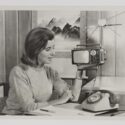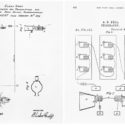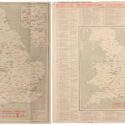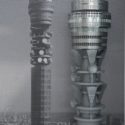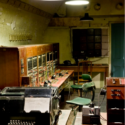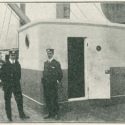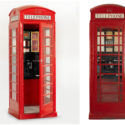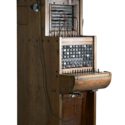History of communications and the Congruence Engine: early thoughts and possibilities
Article DOI: https://dx.doi.org/10.15180/221806
Abstract
Communications is one of three strands of research under the Congruence Engine project, and will follow the other two, Textiles and Energy, in trialling the application of digital methods to better connect and understand collections held in partner institutions. This paper begins with a discussion of definitions of ‘communications’ and an overview of historiography. Interviews conducted by the author with collaborators (in the Science Museum Group, National Museums of Scotland, BT Archives and Historic England) elicit insights into what the Communications strand of Congruence Engine might achieve, obstacles that might be encountered, research directions to pursue and historical questions to ask. Finally, six possible projects are described and discussed.
Keywords
communications, Congruence Engine, digital history, digital humanities, historiography, history of communications, history of technology, telecommunications
Introduction
https://dx.doi.org/10.15180/Working with the collections of project partners, the Congruence Engine aims to find ways of using digital methods, including ways of handling big data sets, to make connections and interpretations, within and between collections, that can answer interesting historical questions about the history and heritage of industry. There are three strands focusing on Textiles, Energy and Communications, running consecutively over the three-year span of the project. Even though the intensive applications of digital methods will be later, as the academic co-investigator on the Communications strand I discuss in this paper some early ideas and aspirations, full in the knowledge that these may change quite radically. Nevertheless, the hope is that the following captures something of the initial thinking about the history of communications within the Congruence Engine.
This paper proceeds in three sections. First, after discussing the broad and narrow definitions of the term I offer an overview of the historiography of communications. Second, the Communications strand, as with the others, is the work of a team, including historians such as myself, curators, collections managers, experts in digital humanities and computing practitioners. In August 2022, collaborators and partners associated with the Communications strand kindly agreed to recorded interviews, conducted by me with the intention of eliciting their conceptions, aims and aspirations. Specifically, interviews were conducted with the following: Wayne Cocroft (Historic England), Geoff Belknap (moving from the National Science and Media Museum, Bradford, part of the Science Museum Group, to National Museums Scotland), Anne Archer and James Elder (BT Archives) and Rebekah Higgitt (National Museums Scotland). Summaries of these reflections are found in the second section. In the final section, after a discussion of available digital methods, I outline early ideas of possible case study projects for communications, some of which (perhaps the more feasible ones) have come from conversations across the Congruence Engine team, notably with Daniel Wilson (post-doctoral researcher on the Communications strand, see also his contribution to this volume). While these ideas may in the end bear little relation to the projects actually attempted many months down the line, they do give a sense of what we thought might be exciting to try.
Historiography
https://dx.doi.org/10.15180/221806/002What should we mean by the term ‘communications’? Many people, and indeed many historians of technology, immediately think of a series of electrical technological systems: telegraph, telephone, radio and television (in both narrowcast and broadcast forms), cellular telephony, up to and including the myriad of internet-enabled networks. Even systems such as organised postal services, book publishing, mechanical semaphore, and so on, tend to be overlooked. Indeed one history of communications (Solymar, 1999) has a short Part One which covers 36 centuries before proceeding in detail from the electrical telegraph onwards. Narrowly, then, we can understand communications as telecommunications.
But ‘communications’ can be understood differently, and more broadly. Partly these differences stem from the perspective used. The narrow sense of communications as telecommunications comes from taking the perspective of electrical systems. If communication is framed as the movement of information then immediately transport systems of all kinds become within its boundaries. If communication is framed as medium and message then attention is drawn to this pairing. If communication is seen as primarily about control then we are pushed towards a cybernetic understanding focusing on feedback loops. Put together these three perspectives have constituted modern communication and information theory, as developed in a highly mathematised form since the mid-twentieth century.
Finally, the most capacious definitions of communication can be found in anthropology and cultural history. Indeed within such perspectives almost all human activity has communicative meaning. Settling on the definition of communication as a ‘dynamic interactive process made up of the organised, purposive, mutually-influential and mutually-recognisable actions and experiences that are created in a variety of modes by and between active participants as they interconnect with each other’, Finnegan (2002, pp 28–29, p xv) exemplifies this breadth when she recollects:
story-telling in West Africa with its songs, movements, and actively performing audiences, of the calls, colours and scents from sparkling displays of produce laid out to entice buyers in a Fijian market, and of the shared experiences, somatic and visual not just acoustic, of musical performances in England. I think of the gestures and unspoken signals of everyday living and of contacts across distance through telephones, letters, presents; also of those variegated family heirlooms, material contacts with earlier generations. I cannot forget either the experiences of reading authors from the long past, Homer’s rhythms and cadences as well his words, and the body-stirring excitements of Greek dramatic metres, with their dances and choruses.
All these, it seems to me, are ways that human beings interconnect with each other – modes of communicating.
Within this huge range of possibilities it is understandable that partners in the Congruence Engine project feel that that the operational definition of communications should align with the interests of collections and their curators. Lighthouses, which might be classed as communications technologies, are in the science collection of National Museums Scotland because, says Rebekah Higgitt (2022), that was an interest of a particular curator. Given ‘the context of working’ at BT Archives, noted James Elder (2022), ‘I have got to…think of communications synonymously with telecommunications’. Elder added two caveats: first, that the provenance of the BT Archives collections (the General Post Office splitting, one half becoming the privatised British Telecom and the other the Post Office) means that there are undeniable entanglements with the non-telecommunications postal services; second he reminded us that the roots were in mechanical systems including semaphore. Anne Archer (2022), also of BT Archives, agreed, but suggested a functional definition: communications are what connects people, and those connections could be a focus rather than the technological systems alone.
Geoff Belknap (2022), with his experience of a range of museums, on the other hand observed that the Congruence Engine project, led by museum people, tends to think in terms of museological categories: ‘things that are the…canonical forms of communication systems or media systems which are easily represented in tangible objects, things like bits of a telegraph…you know, the transatlantic Telegraph wire or Morse code receiver…things like that, that are tangible notions of communication past’. While these categories were ‘critical and important’, there was also a recognition in the project’s design of a broader ‘idea of how information moves across space, which is really hard to collect’. Tracking information in motion, observed Belknap insightfully, is akin to the instruction of Secord (2004) to follow knowledge in transit – a good historiographical clue. Belknap (2022) takes the example of photography to make two further important points: some objects in museums, such as the photographs in the Daily Herald collection at Bradford (see Figure 1), are communicative by design; any photograph therefore could be a subject of the Communications strand. Second, a photograph as ‘a thing that communicates information and also moves across space’ might be very local, moving within a house from camera to album, yet this movement, so important to users, must still be considered communication.

Written history of communications has co-evolved with the invention and use of communication technologies. On the one hand, at the micro-level the late nineteenth-century patent disputes involved intricate reconstruction of, and interpretation and argument about, the sequences of technical development. These patent cases in turn become historical sources, as for example Beauchamp (2015) shows in his account of the importance of the Bell patent (see Figure 2).
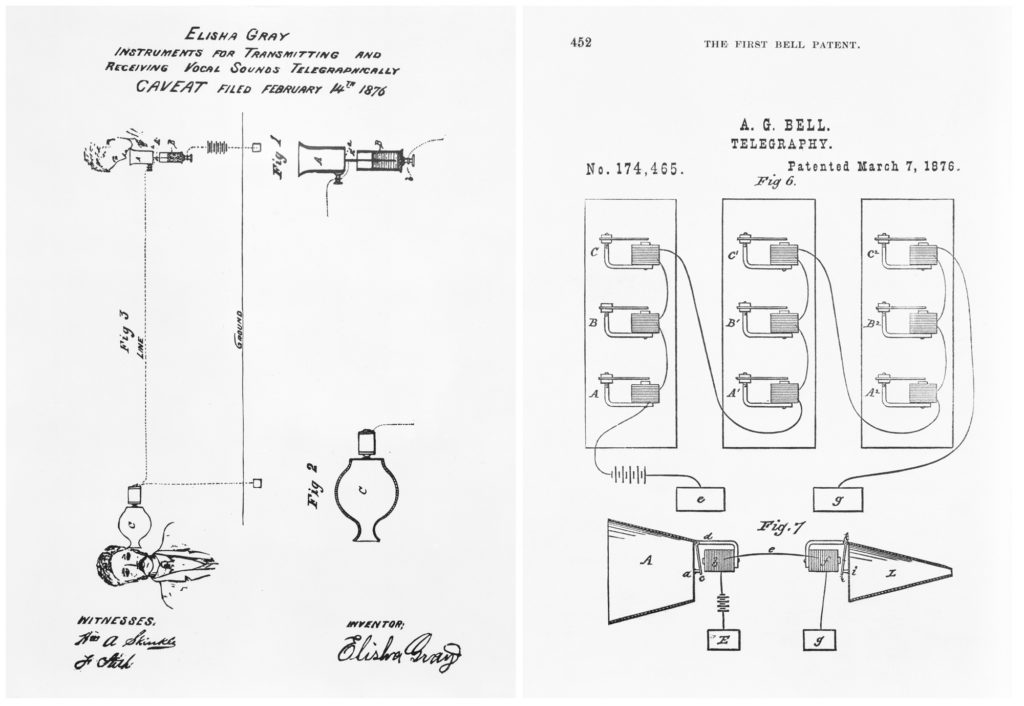
On the other hand, at the macro-level nineteenth-century commentators, such as Dionysus Lardner and Arnold Toynbee, stressed the role of communications in world history, notably in the enduring trope of communications shrinking the globe. While secondary to manufacture, all the leading mid-twentieth century historians of technology – Charles Singer, Lewis Mumford, Siegfried Giedion – paid some attention to communications. The technological systems historiography pioneered by Thomas P Hughes (1983), while finding its paradigmatic case in electric light and power, is equally well-adapted to historical study of communications networks. Within the broader, older traditions of thinking about technology, the Canadian school around Marshall McLuhan (1951, 1962, 1964 and 1967, but also Innis, 1950) was the one perhaps most centrally concerned with communications.
There is a considerable literature on the history of communications (letter, post, telegraph, telephone, radio, television, microwave, mobile phones, and computer networks), often written from national perspectives, for example Fischer (1992) on American telephony. Curiously there is no substantial history of British telecommunications as a whole. There exist authorised histories of the Post Office, but the focus has been on the mail system (Daunton, 1985; Campbell-Smith, 2012); as well as histories of the post office engineers as unionised workers (Bealey, 1976); the telecoms function within the Post Office as a bureaucratic organisation (Pitt, 1980); and the case of British Telecom as one of many privatisations under Thatcher (Parker, 2009). The most detailed recent studies of British telecommunications, with a focus on research, are three doctoral theses that between them address aspects of General Post Office and British Telecom up to the 1980s by Alice Haigh (2020), Rachel Boon (2020) and Jacob Ward (2018).
Communications can be point-to-point, point-to-many, or broadcast. There are histories of leading national broadcasting organisations, taking media history or political perspectives, such as Briggs (1995) on the British case. Significant moments of transition within a communications technology history, such as digitisation or privatisation, have likewise demanded analytical attention. Historiography has often been compartmentalised. There has been a continuing and valuable tradition of engineer-written history (recent examples include Bray, 1995; Varrall, 2012; Beauchamp, 2001; Hawkins, 2017) strong on aspects of technical systems and components, artefacts, if weaker on political and cultural contexts; while the balance is reversed in the studies of communications within business history, political economy, and social and cultural history (Kieve, 1973; Headrick, 1981; Headrick, 1994; Headrick and Griset, 2001; Winseck and Pike; 2007). Yet compartmentalisation can also be countered, for example in the broad vision of communications found within ‘mobility’ studies (which has its own journal, Transfers; see also Morley, 2017).
Where the field is now can be seen by looking at, for example, Gabriele Balbi and Christiane Berth’s 2019 History & Technology paper ‘Towards a telephonic history of technology’. They direct historians in three ways. First, historians of technology should – and this has been a more general recent historiographical trend – pay attention to international, transnational, regional and local contexts as well as national ones. Second (and this historiographical recommendation is specific to history of communications), historians should pay attention to ‘intermedial’ and ‘intertechnological perspectives’. By ‘intermedial’, Balbi and Berth mean the interdependence of different media technologies and the ways in which they interact. Their examples include the telegraph and the post (as telegrams were delivered), the telephone and the fax, and the telephone and the computer. Modems matter! By ‘intertechnological’ they refer to the need to read history of communications technologies alongside histories of other technologies. Mobility as the sign under which communications and transport can be found is a case in point. Third, Balbi and Berth insist that use and users matter. This call, too, is now a familiar refrain in sociology and history of technology (Oudshoorn and Pinch, 2003, which contains a communications case study in Kline, 2003; Edgerton, 1999).
Current trends in historiography of communications align with Balbi and Berth’s message. First, there has been increasing attention to the importance of infrastructure, within which the transnational and regional communications have been well-served, not least by the scholars working together under the Tensions of Europe banner. Fickers and Griset (2019) provide a long history of ‘tecno-political diplomacy in information and communication technologies’, while other volumes in the series, such as Högselius, Kaiser and van der Vleuten (2016) also have valuable perspectives. Second, the links between communications networks and globalisation have been explored, with the study of the Iridium system of satellites that briefly flourished in the 1990s before the global spread of cellular phones by Collins (2018) as particularly pertinent (see Figure 3; see also Agar, 2013, for global aspects of mobiles).
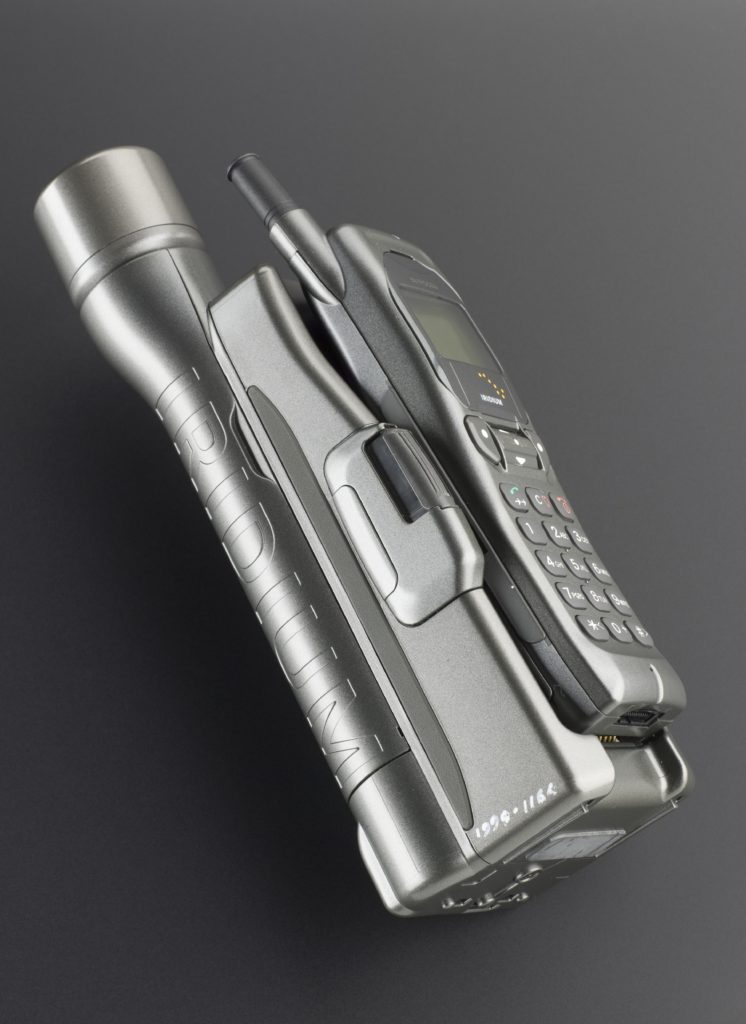
Interesting globalisation studies have reached back into the era of telegraphy, notable examples being Wenzlhuemer (2012) and Müller (2016), a study of the social and cultural creation of a global network that reflects the historiographical priorities of new global history. Third, therefore, historians of communications have contributed to the resurgence of critical histories of imperialism, such as Mann (2017) on public spheres in British India and Choudhury (2010) on telegraphy and imperial power. Such works can be read revealingly alongside older studies such as Innis (1950). Finally, local and user perspectives have continued to be highlighted. One of the most interesting is MacDougall (2014), which follows the tens of thousands of independent telephone exchanges established by ordinary citizens around 1900 in the United States, instigating a battle between these independents and the Bell giant. One wonders whether there are analogous battles of local and centralised power in the British context (perhaps around Hull). Local adaptation of telephonic equipment is also a theme of McGuire (2016).
Most, indeed nearly all, history of communications written by academics uses traditional methodologies of the individual, human examination of documents held in archives. This traditional approach has limits. For example, interesting and ambitious as Balbi and Berth’s manifesto may be, they could nevertheless go further, for example by calling for further integration of message content history with history of communications technology. They don’t, I suspect, because widely dispersed, fragmentary content sources are so difficult to access. Would digital methods, of the kinds trialled in Congruence Engine, help?
Reflections of partners and collaborators
https://dx.doi.org/10.15180/221806/003To explore early ideas and aspirations for the Communications strand of Congruence Engine, partners and collaborators were interviewed by the author (as described above) and asked, in addition to what they understood by communications, other questions: what they would like to see the Communications strand achieve? What might be ‘easy wins’ (focused, early sub-projects with high returns)? What might be a most ambitious achievement? Were there any particular digital tools that they would like to see applied? Which other collections would link to ones under their management? What challenges or obstacles could they foresee, and were there particular historical questions they would like to see answered?
What might the Communications strand achieve?
Higgitt (2022) hoped the strand would achieve a better idea of how collections connect to each other, for example where there are similar objects, or where parts of a story are in different collections.[1] Making such connections visible would be a great assistance to exhibition planners. Archer (2022) also stressed the task of revealing connections, and added that she hoped that the collection under her own management (BT Archives) would thereby be made more discoverable by researchers. Elder (2022) added that he hoped that involvement in the Congruence Engine might benefit internal archival practice, for example that ‘we can pull in the information elsewhere that will help us to correct and improve [iteratively] our catalogue’. Elder considers a focus on ‘authority records’,[2] and how they link to each other, to be a particular such route. Cocroft (2022) also wanted the Communications strand to achieve benefits for his own organisation. Specifically Historic England would gain from a greater understanding of telecommunications sites: where they are; what they were; their dates; technologies; their internal and exterior structures. Unlike in the case of textiles, say, in which historians’ attention to the industrial revolution has made sites well known, there are many communications sites which are thinly known.
Belknap (2022) hoped that what might be achieved would be a ‘holistic sense of what communications objects are’. He also made an interesting, second-order observation. While the aim of all three strands of Congruence Engine is to use digital methods to make connections between collections, the Communications strand has the extra feature of being about connection itself. Communications are connections. As he said:
for me…the Communications strand of this project is one of the most critical because it is [on the one hand about] museum objects…[the] communications technologies represented in collections and how can we connect them. Those are questions we’re asking for Textiles and for other strands of the project. But [on the other hand] in addition to that, communications are also the tools by which the project [will create] the interface between collections.
So it is actually this strand [that is] the glue that ties the entire project together, and I think that’s really interesting. That’s why I’ve been excited to be part of this side of it, particularly around photography or other forms of kind of interstitial objects, things that are about bridging gaps between places.
Easy wins
Wireless stations are examples of sites of interest to Historic England, and Cocroft (2022) suggests mapping interwar stations as an early, achievable project since the numbers are in a range (10s to 100s) likely to be manageable. Comprehensive lists of the relatively few wireless stations up to the First World War are available, while the number of stations increase rapidly during and after the Second World War. Figure 4 shows a map of wireless transmitting stations from 1923. Enticingly, it is surrounded by a list of call signs (as well as names, addresses and details of equipment) – extra data that could, potentially, be linked with information held in other collection data sets such as the 1921 Census.
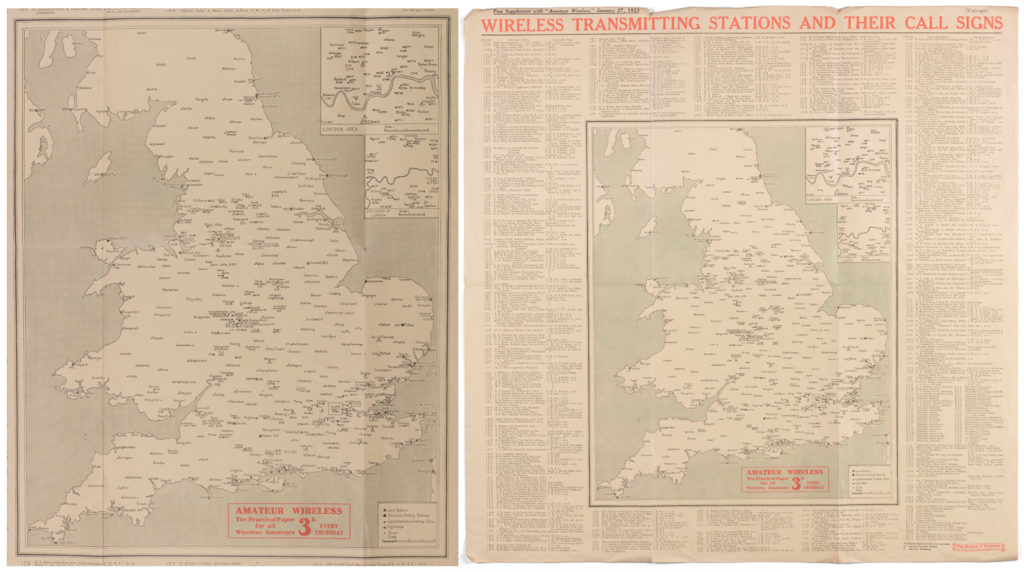
Higgitt (2022) also suggests starting with mapping. Furthermore she points out that a choice of a particular person documented in several collections (for example, John Logie Baird) or particular places on edges of communication networks (such as Scottish islands) might enhance feasibility. Elder (2022) suggests a single building (BT Tower, see Figure 5). Archer (2022) agrees that selecting object categories held in common across collections would be sensible.
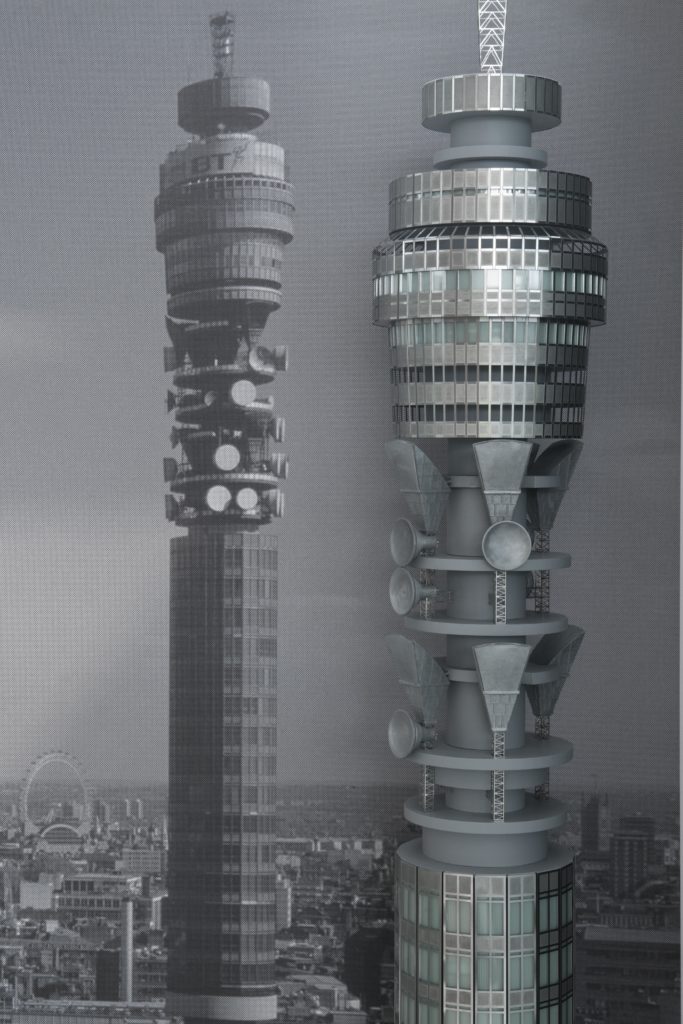
Belknap (2022) suggests starting with photographs, specifically perhaps photographs that have already been the focus of the Textiles or Energy strands. While the other strands would have paid attention to content, in the Communications strand the interest would be in how they moved as information containers.
Elder (2022) argues for starting with areas within collections that are already well-prepared for digital methods by having been scanned or with OCR layers. Born digital documents would also be appropriate choices. BT Archives has documents relating to telephone exchanges, many of which have been scanned.
Most ambitious achievement
https://dx.doi.org/10.15180/221806/004There is a scale of feasibility and return. While Congruence Engine is likely to learn much from ‘fast sprints’ (starting with easy wins), it is also the case that the project is not only a relatively well-resourced digital humanities project and therefore capable of larger-scale sub-projects but it is also charged with exploring the outer edges of what might be possible through experiment. So what did partners and collaborators think might be a most ambitious achievement in the Communications strand? They were encouraged to be speculative.
A ’showcase that really highlights all the connections’ says Archer (2022). A ’completely integrated understanding of all forms of communication technologies’ pitched Belknap (2022), specifically ‘a complete and holistic mapping of all the different types of communications technologies that exist in museum collections’. Elder (2022) imagines ‘a deep natural language processing and analysis of the text of everything that’s been digitized’, which would reveal the links in other repositories, thereby connecting the British Telecom and General Post Office history to that of the implementation of government policy, imperial policy, social history, and labour history (especially trade unions). Cocroft (2022) considered how far the wireless station sub-project could be pushed. If an easy win would be a simple map, an ambitious target would be to capture the details of interior spaces, perhaps generating 3D models. Higgitt (2022) insisted that the sustainability of the outputs of Congruence Engine should be considered. While a central resource that linked collections would be useful it also had to be functional, viable and therefore funded beyond the end of the project. Too many once useful digital tools have not been maintained.
Connections between collections
https://dx.doi.org/10.15180/221806/005Elder (2022), in suggesting telephone exchanges as a focus for an early sub-project, noted that Historic England would have photographs of some exchange exteriors and the National Archives would hold connectable documents in its holdings from the Ministry of Public Building and Works, amongst other departments. Historic England also hold photographs of exchange interiors (see Figure 6), in which equipment is potentially identifiable.
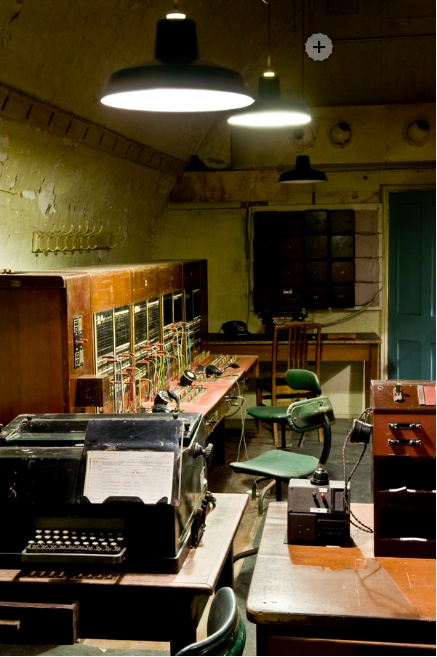
Cocroft (2022), speaking from Historic England, and thinking about radio engineering, noted likely connections with BT Archives within the project, and, outside, the Marconi document archive at the Bodleian and the Marconi exhibits at Chelmsford Museum.
National Museums Scotland’s collections, with its national scope, said Higgitt (2022), have many connections with those of the Science Museum Group as well as National Museums Northern Ireland (perhaps especially if there is a focus on Scottish islands). She also mentioned local Scottish museums as opportunities for valuable collaboration. Belknap (2022) mentioned photographic collections (including private ones); BT Archives; Reuters, if news communication was a focus; and British Library, National Museums Scotland, Science Museum Group, and agencies if the case study was printing. Speaking from BT Archives, Archer and Elder could envisage many connections being made, and mentioned specifically the National Archives, the BBC written archive, the Institute of Engineering and Technology (IET), the British Film Institute (BFI), and the Modern Records Centre at the University of Warwick, the Bodleian Library (again for Marconi), and the Museum of Global Communications (PK Porthcurno) in Cornwall.
Challenges and obstacles
All interviewees could foresee challenges ahead for the Communications strand. These challenges included justifiable concerns about internal resources and time commitments (Archer, 2022), the overwhelming scale of the project if too much is attempted, and connected issues of definition and focus (Belknap, 2022), and the time pressures caused by the slow speed of careful digital history (Higgitt, 2022). More specific problems identified included collection objects not yet currently having enough metadata to work with, for example, ‘negative’ photographs held by Historic England (Cocroft, 2022), and embedded software systems undergoing transitions in terms of level of support (Elder, 2022).
Historical questions
The trends in historiography of communications were outlined above. Ideally the historical questions asked in the Communications strand should engage with the arguments of the best of current scholarship, reflect the interests of collaborators, and use the material and data in partner collections. Furthermore, leading the conversation on the choice of historical collections is one of the responsibilities of the author in the role of Historian of Communications Co-Investigator within Congruence Engine.
Cocroft (2022) considered that interesting questions can be asked of the role of the state, ownership, and movement of technically trained workers within the communications sector. Specifically, he suggests following the movement of radio engineers and others employed within Marconi. Marconi mainly trained male wireless operators to work on ships (see Figure 7), but it might be possible (perhaps through photographs and films as sources) to trace gender roles in relation to telecommunications, for example in relation to the manufacturing industry and in interaction with various telecommunications interfaces.
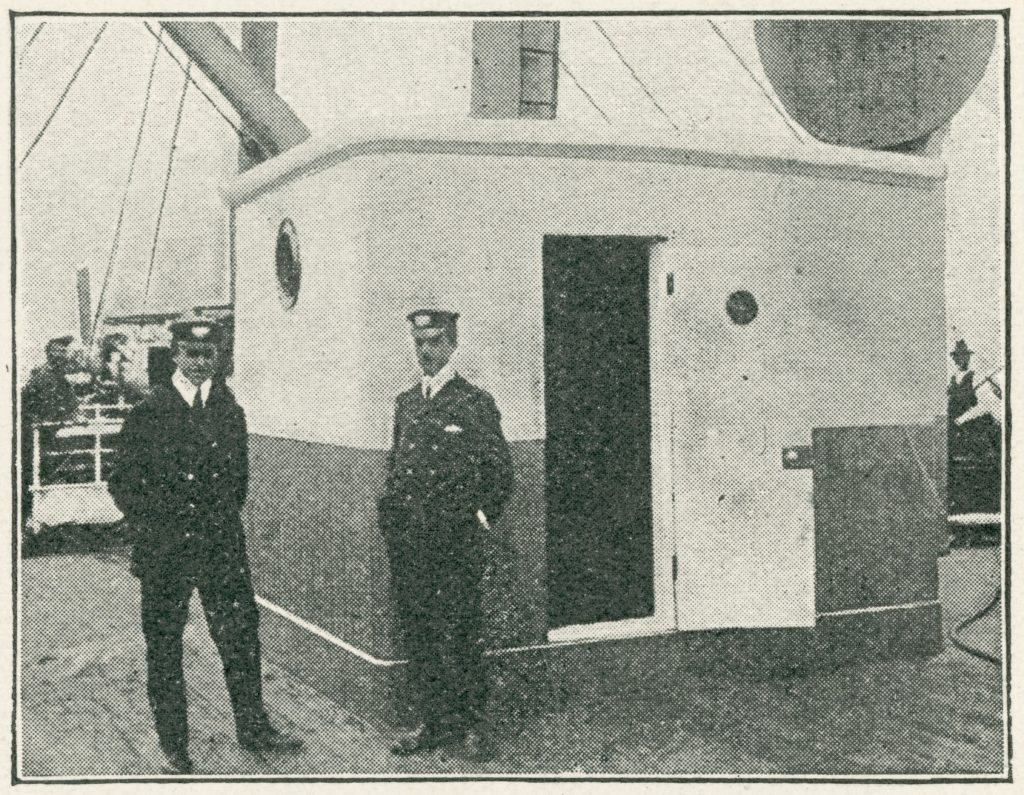
Cocroft offers a second idea: starting from places of manufacture associated with communications equipment might allow the exploration of full life-biographies for objects: from place of manufacture, through use (ideally located), and in some cases on to museums. Moving backwards, supply chains of wood, plastic, glass, copper, rare metals and so on could also be traced into the manufacturing sites. Answering such questions would assist Historic England, including in its need to better understand radio station sites. From within BT Archives, Elder (2022) asked whether it was possible to measure technical progress within telecommunications to the extent that arguments about the limits of innovatory capacity of the general Post Office and later British Telecom could be reassessed.
In contrast, Belknap and Higgitt, from the perspective of more general, national collections, suggested more general collection-oriented questions. Higgitt (2022), for example, asked whether the representativeness of the collections could be assessed. Can gaps in collections be identified in ways that assist future acquisition choices? Inspired by scholars such Latour, Secord and Darnton to follow circulations, Belknap (2022) suggests not just looking for epistemic consequences (where does knowledge move?) but also material consequences (where do things go, including, in some cases, to museum collections? How do they accrue and shed information as they move?).
Specific suggestions of possible projects
https://dx.doi.org/10.15180/221806/006There already exists a deep overlap between digital humanities and the history of communication. In particular, digitisation of texts, especially published books and newspapers, both of which can be classed as communication technologies, has resulted in enormous data sets of historical interest. These data sets have been the main resource for digital history. The historical questions asked of big data sets tend not to be about the history of the medium but rather about the content. Text-mining of digital newspapers, in the three cases reviewed by Eijnatten, Pieters and Verheul (2013), for example, was used to answer questions about public debates and discourses about drugs, heredity and transatlanticism rather than the history of newspapers as a technology. We in the Congruence Engine, however, will be interested in the history of technical media as well as message.
The following discussion of possible projects reflects this opportunity and choice. Ideas about possible projects have been presented twice (internally, at Saltaire in the first Congruence Engine meeting and, to an external audience, at the British Society for the History of Science annual conference in Belfast). The ideas are preliminary and will continue to evolve. Actual projects attempted in the months ahead may be very different. Nevertheless the following provides a record for future comparison and reflection.
(1) Linking objects within and between collections
https://dx.doi.org/10.15180/221806/007An important and obvious step towards a national collection would be to know which objects are either duplicated (if identical) or form close and complementary connections (if of the same narrow class) across collections. (Note that these linkages may also be within collections and not yet be recognised by collection holders.) To take one example, telephone kiosks – the famous red telephone boxes – are present as objects in both the Science Museum Group collection[3] and that of the National Museums Scotland (see Figure 8).[4] There are almost certainly others.
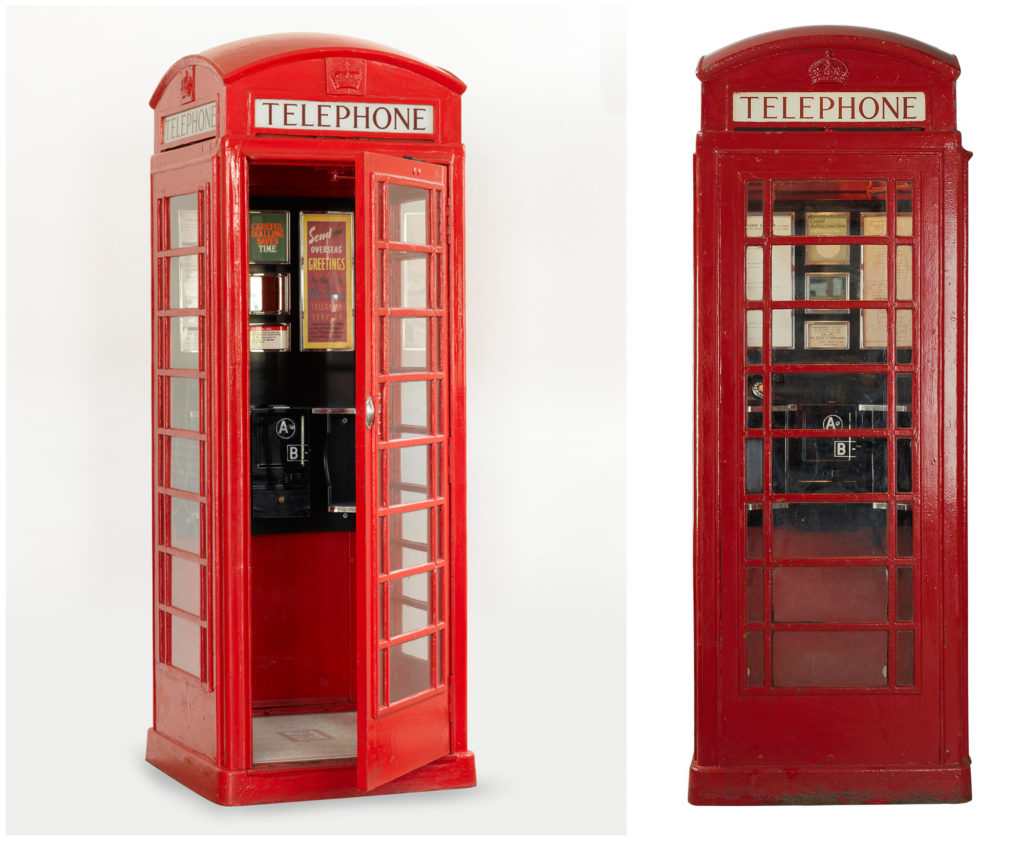
The catalogues and metadata of the collections, starting with those of the partners of the Congruence Engine project, should be systematically searched for pairings of identical or very similar communication technology objects. The search could be pushed further if representations of such objects can be identified and labelled (in the above case, for example, the presence of telephone boxes in photographs). Pushing this search even further would involve looking for textual representations of objects (in the above case, written references to kiosks, likely to be present in immense quantities in the BT Archives) and such text-mining methods lead us to into the next possibility.
(2) Link collection objects to stories in other textual data sets, especially thinly-storied objects
https://dx.doi.org/10.15180/221806/008Some objects have been extensively researched by historians using traditional methods. The long tail of objects held in national collections, however, has not received such time-consuming, dedicated attention. It is these thinly-storied objects which can and should be the focus of the digital methods trialled by the Congruence Engine.
A good example has been provided by Alison Taubman of the National Museums Scotland. It looks like a piece of solid wooden furniture, perhaps an unusually tall writing desk, with panels of plugholes (see Figure 9). It is, says Taubman (2021), the ‘only manual exchange on [the Scottish Inner Hebridean island of] Jura, installed in the home of operator Effie MacDougall until automated in 1974’.[5] The object has already been linked to a small amount of textual sources, held on file, including reporting of the end of manual switchboards on three Scottish islands, Islay, Jura and Colonsay, in the Dundee-based People’s Journal (Anon, 1974, p 21). Taubman also reports a cultural link: George Orwell must have used the telephone during his stay on Jura in the late 1940s, when he wrote 1984. In addition to similar objects being located in other collections (see project 1 above) there should also be other textual references to the manual telephone exchange on Jura or to people associated (the operator MacDougall, references to Orwell making telephone calls in his diaries and correspondence, and so on). Using digital methods to fill out such otherwise thinly-storied objects (including ones much less storied than Jura’s exchange) would be a valuable task for the Communications strand of the Congruence Engine. Furthermore, such linkages are likely to be of direct use to collections holders, saving time and making connections otherwise missed.
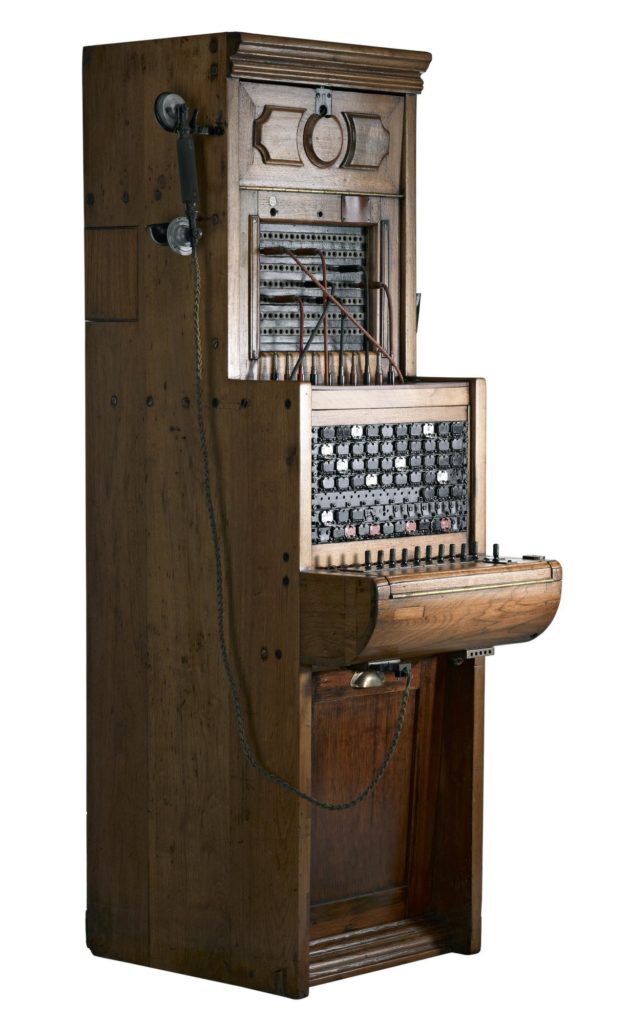
(3) Mapping objects to places
https://dx.doi.org/10.15180/221806/009An interest in mapping was clearly expressed in interviews with partners and collaborators (Cocroft, 2022; Higgitt, 2022). Specific projects on mapping communication objects and networks are discussed below. But there is also a more general point to make and a project to propose. Among the metadata of collection catalogues there are plenty of geographical references: places of installation and manufacture, addresses of persons and businesses, and so on. There are also other data sets that are rich in information about locations. Much could be gained by bringing these two together.
The rich data sets I have in mind are directories. Directories contain information about people, institutions, trades and professions, and much else (including advertisements), usually listed at local, county or city level. They include plenty of location-specific information, notably addresses. Some, but not all, directories for areas within the United Kingdom have been digitised. The University of Leicester led a Lottery-funded project (Historical Directories) in the 2000s resulting in the digitisation of 689 directories, with all items published under a Creative Commons Attribution-NonCommercial 2.0 UK license and plain text and TIFF files available in the UK Data Archive.[6] National coverage is present through the selection of at least one directory per county-scale area, while certain decades (1850s, 1870s, 1910s) have more digitised sources than others. For the 1910s, for example, available directories include the Post Office London Directories (including suburbs) and the Kelly’s Directories for counties. To take one specific example, the Post Office London Directory, 1915. Part 3: Commercial & Professional Directory has street, telephone and telegraphic addresses for alphabetised persons. Cross-linking addresses in Congruence Engine partner catalogues with such Directory addresses would surely be valuable. Further cross-linking to Wikidata would deepen the combined data set again.
Interesting historical questions could then be posed of the combined data set. It would be possible, for example, to map out the locations and names of all companies involved in the telegraphic industries (manufacturers, component suppliers, consultants, engineers, and so on). There are constraints, both spatially (the incomplete geographical coverage) and temporally (far stronger in the nineteenth than twentieth centuries). If access could be secured, and digitisation conducted if necessary, to more recent telephone directories then the data set would be expanded. Could we have it all?
(4) Mapping communications infrastructures
https://dx.doi.org/10.15180/221806/010Mapping catalogue information to addresses (project 3) tells us little about the shape of the networks which are such a distinctive feature of communication technologies. There is strong interest among Congruence Engine researchers in mapping communications networks (Cocroft, 2022; Higgitt, 2022). Cocroft’s proposal of identifying and mapping radio stations is noted above. Again there is likely to be a mixture of well-documented and thinly-storied sites. Not every radio station, for example, has received the thorough historical and archaeological survey that Historic England (then English Heritage) researchers conducted and wrote up about the international short-wave radio station at Cooling on the Hoo peninsula in Kent (Newsome and Gregory, 2010). Location information about radio stations, and also information of how they networked, will be distributed across many archives. Nevertheless an output could be a map of stations and their networks.
(5) Comparing infrastructural geographies
https://dx.doi.org/10.15180/221806/011We can imagine compiling dated historical maps of telegraph, telephone, radio and data communications networks at the national scale. The comparison of such maps would reveal patterns in network growth. Even more intriguingly the comparison across technologies (the intertechnological and intermedial aspects highlighted for study by Balbi and Berth, 2019) would be invited. It is well-known, for example, that telegraph networks grew alongside and therefore were co-patterned with railway networks (Fari, 2015, p 59, calls it a ‘symbiosis’). But what other similarities (and contrasts) can be found, and what factors would account for them? At first glance, for example, the UK motorway network that grew from the late 1950s is quite similar to the JANET packet-switching network built in the 1980s and 1990s.
(6) Reunite medium and message
https://dx.doi.org/10.15180/221806/012Communications consist of both the material network technologies and the information that passes across them, the medium and the message. Is there a way of relating the mapping of telegraph cables say to telegraph content, or emails to email networks. What about the even more ephemeral records of conversations to telephone? Even more ambitiously, can we trace circuits of communication, intermedially across technologies while still tracking content? Sources relating to content are likely to be even more scattered across the collections and archives than sources that relate to material network technologies. The former have generally been much harder for the historian to assemble than the latter (although there are exceptions, for example, book content is more readily accessible than the documents that would be used to reconstruct the history of publishing). But this challenge is of the kind that the Congruence Engine should be attempting as it trials applications of big data methods.
The results would be valuable to historians and to curators of collections. The need to collect sparsely distributed communication content has been already recognised. In a fascinating public history project carried out in preparation for the Science Museum’s Information Gallery and in collaboration with National Museums Scotland, visitors were asked to bring in their telegrams with the option of having them scanned and collected as digital copies. Kirke Kook, a National Museums Scotland Collections Volunteer and Community Collector, noted that ‘museums, when displaying the history of communication, usually concentrate on the thrilling machinery used to send telegrams, the stories that telegrams tell have remained largely unexplored’ (Kook, 2013). The collection and scanning of these telegrams donated by the public was essentially done by hand. Imagine what might be possible with the scaled-up methods available to the Congruence Engine.
Conclusion
https://dx.doi.org/10.15180/221806/013Many of the project partners have collections that include material artefacts, archived documents, data and metadata that relate to the history of communications. There are further artefacts and documents in collections distributed, preserved, interpreted and displayed as part of the BT-funded Connected Earth project which ran for a decade from 2001.[7] There is some, but not complete, overlap between the partners involved in Connected Earth and Congruence Engine. Together, however, the two networks include most of the organisations responsible for the collected heritage of communications in the UK.
The Congruence Engine has ambitious aims to create a digital toolbox that might be used to connect items from the nation’s collection in ways that handle more sources than is possible with traditional methods, a greater variety of types of sources than before, using advanced techniques (including machine learning and natural language processing) in ways that historians, curators and others find useful. What it can do in practice is, in an exciting sense, unknown. It is an experimental project by design. This paper has described what the possibilities might be for the Communications strand of the project from the perspective of historians, partners and collaborators. It has also surveyed the historiography of communications. In summary, there are many exciting potential projects that we are eager to pursue.



